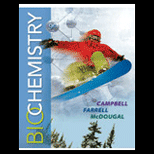
Concept explainers
RECALL Which reaction or reactions that we have met in this chapter require ATP? Which reaction or reactions produce ATP? List the enzymes that catalyze the reactions that require and that produce ATP.
Interpretation:
The reactions that require and produce
Concept introduction:
Glycolysis is a metabolic pathway that converts one molecule of glucose into two molecules of pyruvate.
Glycolysis is an anaerobic process that occurs in the absence of oxygen.
Glycolysis is the fundamental system of sugar metabolism in the body that contributes to the production of energy in the form of
Answer to Problem 1RE
Solution: The first step of glycolysis, which is the phosphorylation of glucose to glucose-
The step involving the phosphorylation of
Explanation of Solution
The phosphorylation of glucose to glucose-
The step where
Glycolysis results in the production of two molecules of
Want to see more full solutions like this?
Chapter 17 Solutions
Bundle: Biochemistry, Loose-leaf Version, 9th + Owlv2,1 Term Printed Access Card
- The following data were recorded for the enzyme catalyzed conversion of S -> P Question: what would the rate be at 5.0 x 10-5 M [S] and the enzyme concentration was doubled? Also, the rate given in the table is from product accumulation after 10 minuets of reaction time. Verify these rates represent a true initial rate (less than 5% turnover). Please helparrow_forwardThe following data was obtained on isocitrate lyase from an algal species. Identify the reaction catalyzed by this enzyme, deduce the KM and Vmax , and determine the nature of the inhibition by oxaloacetate. Please helparrow_forwardIn the table below, there are sketches of four crystals made of positively-charged cations and negatively-charged anions. Rank these crystals in decreasing order of stability (or equivalently increasing order of energy). That is, select "1" below the most stable (lowest energy) crystal. Select "2" below the next most stable (next lowest energy) crystal, and so forth. A B 鹽 (Choose one) +2 C +2 +2 (Choose one) D 鹽雞 (Choose one) (Choose one)arrow_forward
- 1. Draw the structures for the fats A. 16:2: w-3 and B. 18:3:49,12,15 2. Name each of the molecules below (image attached)arrow_forwarddraw the structures for the fats A. 16:2:w-3 B 18:3:9,12,15arrow_forward1. Below is a template strand of DNA. Show the mRNA and protein that would result. label the ends of the molecules ( refer to attached image)arrow_forward
- Attach the followina labels to the diagram below: helicase, single stranded binding proteins, lagging strand, leading strand, DNA polymerase, primase, 5' ends (3), 3' ends (3) (image attached)arrow_forward1. How much energy in terms of ATP can be obtained from tristearin (stearate is 18:0) Show steps pleasearrow_forwardMultiple choice urgent!!arrow_forward
 BiochemistryBiochemistryISBN:9781305961135Author:Mary K. Campbell, Shawn O. Farrell, Owen M. McDougalPublisher:Cengage Learning
BiochemistryBiochemistryISBN:9781305961135Author:Mary K. Campbell, Shawn O. Farrell, Owen M. McDougalPublisher:Cengage Learning
